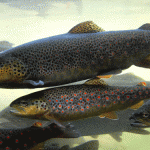The pollen print
French forensics pioneer Edmond Locard famously stated that every contact leaves a trace. This is a defining principle of forensics. Trace evidence may be clothing fibres, a fingerprint or DNA from blood or hair. Or it could be pollen.
Bees, like other animal pollinators, pick up the grains as they travel from flower to flower, collecting nectar and pollen for food and nest building. Pollen grains that travel on animals tend to be relatively large (up to 200 microns, or 0.02 of a centimetre, across) and can be elaborately adorned. These adornments may have evolved to help the grains attach to animals or to the stigma, the female receptive organ on a flower.
Wind-dispersed pollen is usually smaller (five microns at its tiniest), smoother and more plentiful, but it’s no less striking. A glance at the grains in a scanning electron microscope explains why palynologists refer to pollen’s artful topography as “sculpture.”
Surprisingly, not all pollen is spherical. Some are disc-like, some football-shaped and some triangular. The pollen of a particular species even differs from that of its closest relatives. Spores, the reproductive cells of the planet’s roughly 26,000 described ferns, mosses and other primitive, asexual plants, also vary from one another. All this diversity of shape and size means there’s a different “fingerprint” for every plant in the world. These fingerprints are the domain of forensic palynologists, a small group of experts who use pollen and spores to link objects and people to crime scenes.
And just as every plant has its own fingerprint, every location too has a distinct “pollen print,” the assemblage of different types of pollen and spores present on the scene. Matching the pollen print from a crime scene to samples found on a suspect’s belongings may place the person at the scene. If a suspect denies having been there, pollen may show that he’s lying. And if a victim and suspect have the same pollen profile on them, it can often be concluded that both were at the same place at the same time. “Pollen is one of the most powerful techniques in trace and contact evidence,” says Patricia Wiltshire, a forensic ecologist, botanist and palynologist at the University of Gloucestershire in England, which leads the world in the use of forensic palynology.














